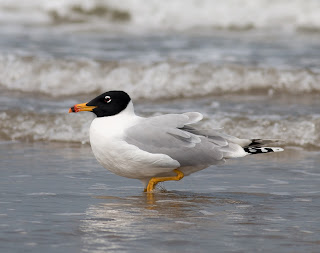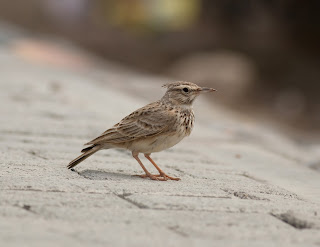Our flight to Muscat from Heathrow took 8 hours. We set off
at 20.00 on the 17th and, as a result of the 4 hour time difference,
arrived at around 7.00 the following morning. It took us over 2 hours to get
through customs and pick up the car but were finally ready to go just before
10.00 that morning. The first birds we saw besides Feral Pigeon were Common
Mynas and Laughing Doves, which
we found to be extremely abundant in the capital. We decided to drive through
to a small park/nature reserve on the eastern side of the city called Al Qurm.
Our drive across provided us with the first of our trip target species in the
form of Indian Roller, which were
fairly abundant along grassy verges and gardens in the capital.
Al Qurm
The park itself did not open its doors until 15.00 so we
decided to set up on the adjacent beach and bird around there. The birding was
easy here, with both Greater and Lesser Sand Plovers, Slender-billed and Heuglin’s Gulls and an assortment of Terns; Saunder’s, Greater Crested and Lesser Crested. From the gull flock we
picked out a superb full summer plumaged Pallas’s
Gull, which was one of the highlights for the whole trip. Looking behind us
out over the reserve itself gave us our first wetland species such as Great White and Western Reef Egret. The scrub alongside the shore also contained Crested Lark, which were extremely
approachable. House Crow was also present in the area, already racking up the lifers.
-Saunder's Tern
-Slender-billed Gulls
-Greater & Lesser Crested Tern
-Greater Sand & Kentish Plover
-Pallas's Gull
-Crested Lark
After an hour or so biding the beach we decided to move back bird the outskirts of the park. We walked around the perimeter of the park where we managed to pick up a surprising number of northern Oman species. Little Green Bee-eater was abundant, as was Purple Sunbird and both Red-vented and White-cheeked Bulbul. A small grassy football pitch provided Red-wattled Lapwing and Grey Francolin, although the former was fairly common of rough areas of ground around Muscat. Continuing to work the bushes and looking into the park itself produced more results, with Isabelline Shrike, Indian Silverbill, Graceful Prinia and Eastern Eastern Black Redstart all using the area.
-Purple Sunbird
-White-cheeked Bulbul
-Red-vented Bulbul
-Little Green Bee-eater
-Indian Roller
By lunchtime we decided to head off east, our target
destination being Ras Al Hadd on the north-east coastline. We made a supply
stop in Oman and topped up on food and water. The drive across took between 2-3
hours, but we picked up more species on the drive across. Egyptian Vulture was the only raptor in any abundance, but we did
also have a Short-toed Eagle. We
also had our first wheatears of the trip with a cracking male Variable Wheatear a nice surprise, several
Red-tailed and a female Desert
Wheatear all sat up on the roadside.
-Variable Wheatear
-Red-tailed Wheatear
Species List:
Al Qurm, Muscat: Common
Myna, House Sparrow, Indian Roller, Laughing Dove, White Wagtail, Collared
Dove, Lesser Crested Tern, Greater Crested Tern, Saunder’s Tern, Sandwich Tern,
Grey Heron, Western Reef Egret, Great White Egret, Kentish Plover, Greater Sand
Plover, Lesser Sand Plover, Curlew, Curlew Sandpiper, Dunlin, Bar-tailed
Godwit, Greenshank, Terek Sandpiper, Ringed Plover, Ring-necked Parakeet,
Isabelline Shrike, Osprey, Crested Lark, Common Teal, Swallow, Rock Martin,
White-cheeked Bulbul, Red-vented Bulbul,
Indian Silverbill, Slender-billed Gull, Pallas’s’s Gull, Heuglin’s Gull,
Red-wattled Lapwing, Grey Francolin, Eastern Black Redstart, Little Green
Bee-eater, Graceful Prinia Chiffchaff, Black-headed Gull, Purple Sunbird, House
Crow,
Driving: Indian
Roller, Variable Wheatear, Egyptian Vulture, Short-toed Eagle, Marsh Harrier, Collared
Dove, Desert Wheatear, Little Stint, Black-winged Stilt, Redshank, Greenshank,
Red-tailed Wheatear, Sooty Gull,
Ras Al Hadd
Once we arrived at Ras Al Hadd it was already early evening
and the light was beginning to fade. We checked the shoreline for waders and
gulls, which produced a good number of common waders plus Caspian Tern, Sooty Gull and more Pallas’s Gulls. A check of the scrub behind the shore, even in the
low light, produced a good number of commoner desert species; Tawny Pipit, Black-crowned Sparrow Lark and
more Desert Wheatears.
We chose to camp in a small area of desert just inland from
Ras Al Hadd. By the time we camped it was already dark but a search of the
scrub found us a number of Ground
Geckos, a Worm Snake and a Saw-scaled Viper. you define this
to species in the list? The Worm Snake is particularly impressive as they very
rarely come up above ground.
-Middle Eastern Short-fingered Gecko
-Hooked Thread Snake
-Wahiba Spider
-Sochurek's Saw-scaled Viper
Species List:
Ras Al Hadd: Tawny
Pipit, Caspian Tern, Black-crowned Sparrow Lark, Oystercatcher, Greenshank,
Kentish Plover, Greater Sand Plover, Lesser Sand Plover, Curlew Sandpiper,
Whimbrel, Bar-tailed Godwit, Curlew, Crested Lark, Grey Heron, Desert Wheatear,
Laughing Dove, Feral Pigeon, Slender-billed Gull, Pallas’s Gull, Sooty Gull,
House Sparrow, Sandwich Tern,
























Hello Daniel,
ReplyDeleteGot to say that your Pallas's Gull image of the lone bird in the water is great, the quality is very good i'm guessing the birds allowed you to approach fairly close packing the image with detail must of been a DSLR ?
Regards Michael